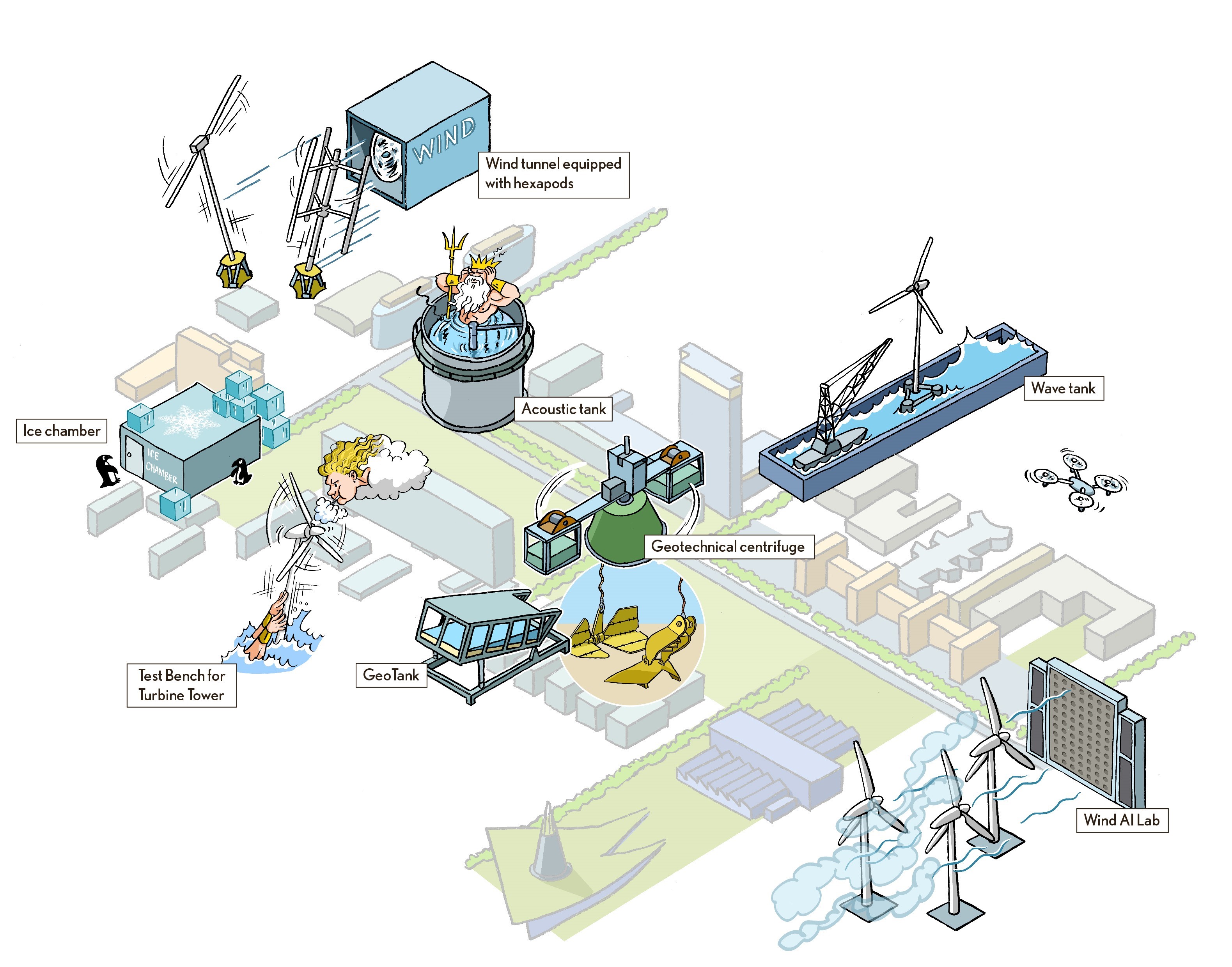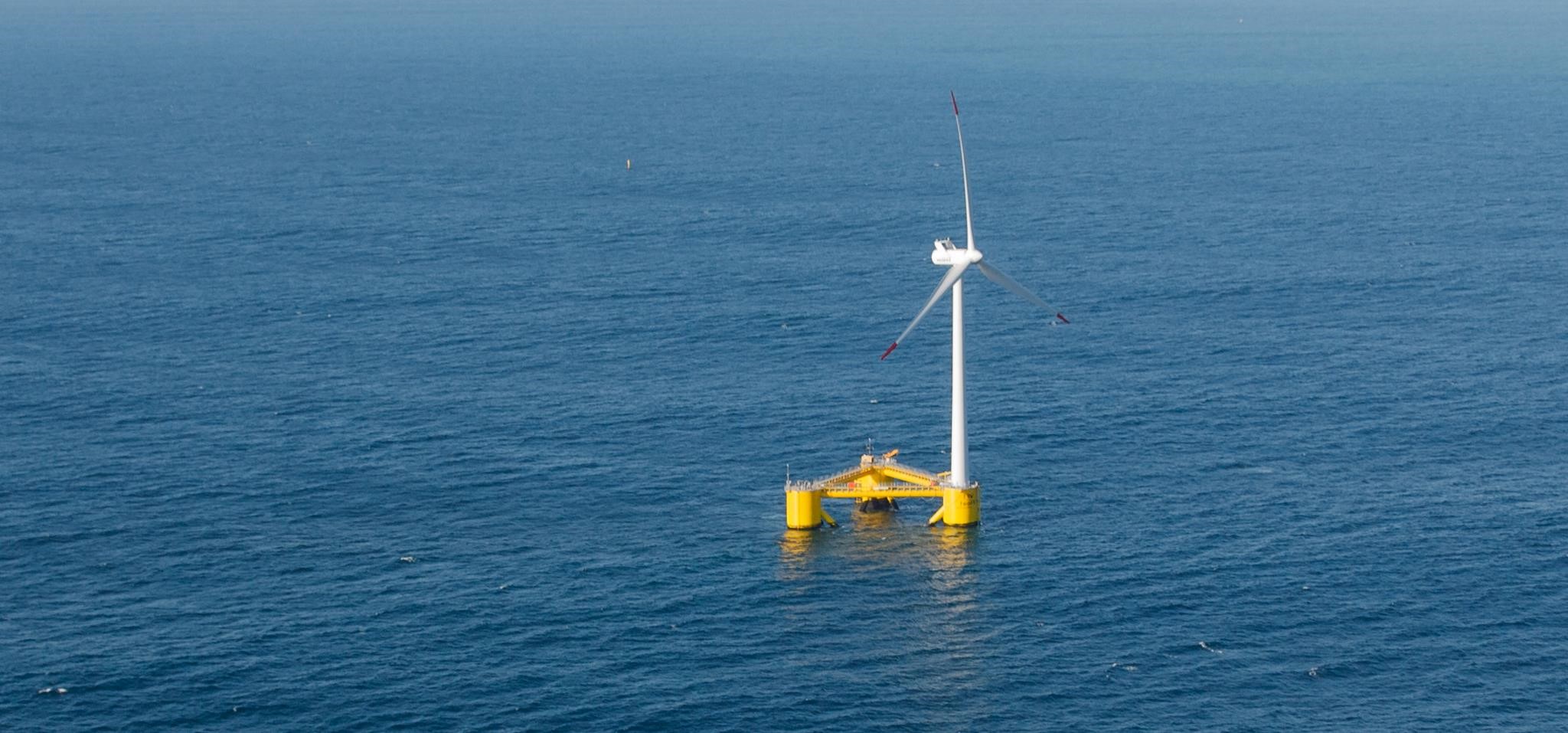Axelle Viré (Associate Professor of Floating Offshore Wind) talks about the new Floating Renewables Lab
In order to become climate neutral by 2050, the share of renewable energy generated at sea will need to increase significantly. Floating wind turbines, solar panels and tidal power plants will play a crucial role in this. TU Delft’s new Floating Renewables Lab will give research and innovation in this area a major boost. Good for the climate, the economy and the Netherlands, says Axelle Viré, Associate Professor of Floating Offshore Wind Energy.
The turning point came recently, only a handful years ago. Everybody seemed to realise that there was ‘no way’ we were going to achieve climate neutrality with only ‘fixed wind’ (traditional wind turbines in the shallow waters of the North Sea). “We simply don’t have enough shallow water to achieve that ambition,” Viré explains.
The researcher, who is attached to the Faculty of Aerospace Engineering, has been doing research on floating wind turbines, which are anchored to the seabed with cables, for almost ten years. It is a technology that is still in its infancy. It was at the end of her PhD research around 2010 that Viré became fascinated with floating wind turbines, when she read on the news how the Norwegian oil company Statoil (nowadays Equinor) deployed the first full scale prototype of floating wind turbine.
Scepticism
Initially, a lot of people were sceptic about floating wind energy. “Many people wondered if this would ever become a reality.” But that did not stop Viré from persevering. She won a prestigious research grant and now works full-time on ‘floating wind’. She is glad that most people have by now come around. “It’s nice to see, because it means things are going to start happening – and fast!”
But there are still major technical challenges. Innovations are required in all areas, from fundamental research and design and control, to mass production and the actual roll-out of floating wind turbines.
Atlantic Ocean
The potential is huge. Eighty per cent of European waters are too deep for traditional wind turbines. Floating wind turbines are expected to generate around 150-200 gigawatts in the coming decades. To compare, there are currently about 12 gigawatts of ‘fixed’ wind turbines, and the current yield of floating wind does not yet add up to even a single gigawatt. Last January, Scotland was the first region to announce serial projects totalling 15 gigawatts of floating wind turbines.
RECOMMENDED: Towards a renewable offshore energy system
The wind is often the strongest in deeper waters such as the Atlantic Ocean, but this technology also offers a solution for countries without shallow coastal waters, such as France and Norway. “For these countries, offshore wind means floating wind.”
A key enabler for hydrogen
In addition to generating electricity, the floating wind farms will also be used to produce hydrogen. Viré calls this the ‘key enabler’. Hydrogen is much cheaper to transport than electricity, so it's more efficient to produce it far away, in deep water. “This requires floating renewables.”
The technological challenges lie mainly in the combination of wind, waves, ice formation and the sea floor (aerodynamics, hydrodynamics and soil mechanics), which all influence the behaviour of a floating wind turbine. When the wind changes, the way the turbine moves on the water also changes. In a traditional wind tunnel, you can only measure the influence of the wind, not the interaction with the sea.
Hexapod
In the Floating Renewables Lab, eight existing facilities have joined forces to investigate these different aspects together (see illustration). In addition to a wind tunnel and wave tank, the facilities include an acoustic tank to calculate the noise produced by offshore systems underwater, an ice room to simulate the influence of floating sea ice, and a geotechnical centrifuge to record the interaction between the cable that holds the platform in place and the seabed.
The facilities will be further equipped with ‘hardware-in-the-loop’, such as hexapods (large six degrees of freedom robots) that are driven by a numerical model to mimic the influence of waves in the wind tunnel.
Machine learning
Artificial Intelligence (AI) will also play an important role. “To do realistic tests, you need to be able to simulate waves in real time,” Viré explains. High-fidelity models are often too slow for this. Machine learning enables such a real-time simulation. “We use AI to ensure accurate, high-quality test results without sacrificing speed.”
Artificial intelligence is also used to control the wind turbines as part of a wind farm. This takes place in the Wind AI Lab, led by Professor of Data-Driven Control Jan-Willem van Wingerden (Faculty of ME). The result: the Floating Renewables Lab can test all aspects of floating wind turbines in near real-life conditions.
Wind tunnel learns from wave tank
The experiments do not only take place separately at the eight facilities; they also build on each other’s work. “In the wind tunnel, we use real wind and a numerical model that enables the hexapod to simulate the floater’s movements,” explains Viré. The model has to be accurate, however, and for this purpose data from the wave tank can be used.
“At the same time, we test with real waves in the wave tank and use a model to simulate the influence of the turbine. So that model, in turn, learns from the wind tunnel data.”
Unique in the world
The eight individual facilities are not unique in themselves, but the combination is. “At sea, it is difficult to isolate individual effects. Performing tests at lab-scale under controlled conditions is better suited for improving our fundamental understanding of the phenomena.” says Viré. “In this lab, we can compare the output of various complementary hybrid test rigs and improve our models according to the data from all eight facilities. That is unique in the world.”
In the long run, the lab will increase confidence in lab-scale testing and reduce the need to go to sea for testing, hence reducing costs. “Offshore demonstrators are very expensive,” she explains. It is essential to cooperate with the industry to accelerate the large-scale development of floating wind farms, so that the knowledge gained in the Floating Renewables Lab can quickly flow into new applications.
Economic growth
This knowledge sharing is of the utmost importance. Innovation across the board is a prerequisite for success. “For example, it is still not clear what the best type of floater is for a wind turbine.” The same applies to the design and control of the turbine, Viré continues. It will be a huge challenge to roll out this technology on a large scale. “So we need innovation at both the fundamental level and the production level.”
The Netherlands can benefit from this. Although the country does not have a lot of deep coastal water, Dutch companies are very active in the offshore sector and involved in the construction of the floating wind farms in Scotland, for example. “Logistics, infrastructure; the whole economy will benefit, especially in combination with hydrogen production,” Viré expects.
End user benefits
The same applies to the public; the end users. Consumers will eventually need to switch to renewable energy, and floating renewables will help to achieve this. “The large-scale roll-out of floating wind and solar parks will speed up the transition to clean energy in the Netherlands.”
Viré is part of TU Delft’s Accelerator Team, which aims to accelerate research and innovation for the energy transition. Floating renewables play an important role in this. “Many governments want to significantly increase the amount of wind energy as early as 2030. This will be impossible without floating wind farms.”
Accelerating innovation
Following that favourable wind of change in recent years, the Floating Renewables Lab represents a new turning point for Viré. “We want to make a positive impact and accelerate innovation with floating wind.” She also wants to inspire new students, because the industry is desperate for talents.
Reflecting on the progress made in her field – after all the scepticism – she concludes: “It is unbelievable that less than ten years ago many people did not believe this could be done.” It shows that, as a researcher, you sometimes have to be stubborn, says Viré. “If you have good ideas, then stick to them.”



